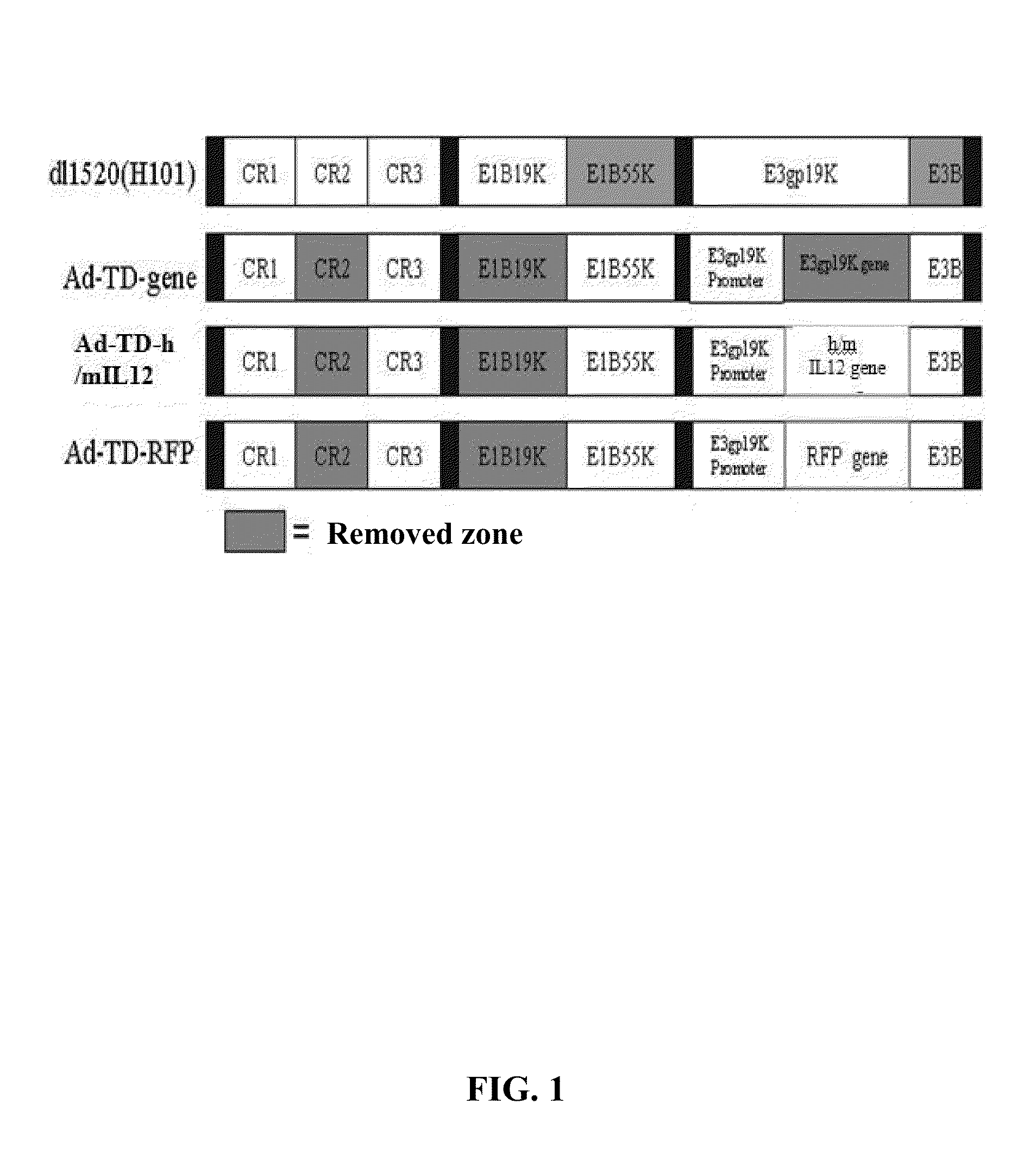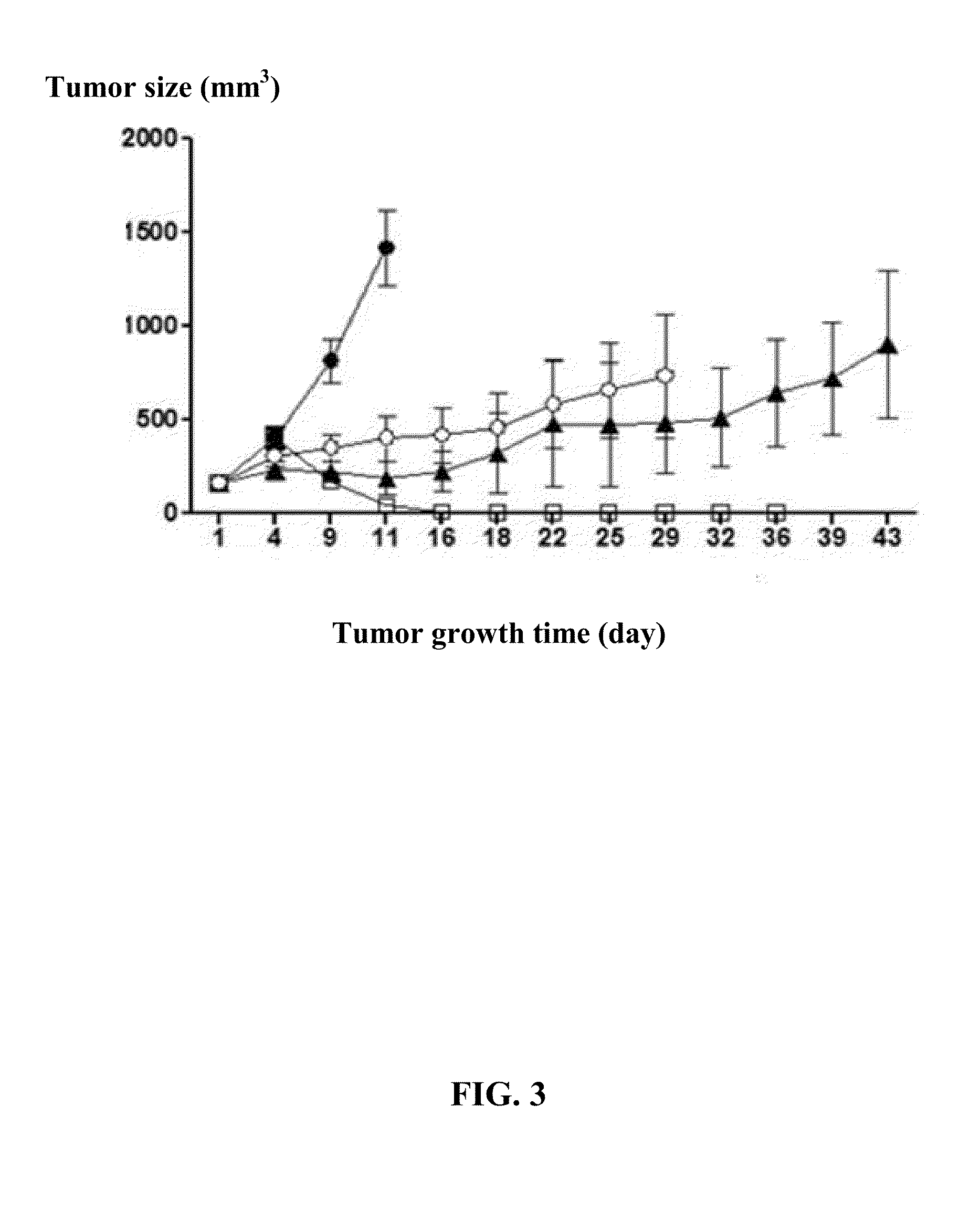Targeted oncolytic adenovirus for treatment of human tumors, constrcution method and application thereof
- Summary
- Abstract
- Description
- Claims
- Application Information
AI Technical Summary
Benefits of technology
Problems solved by technology
Method used
Image
Examples
example 1
[0041]Structure of a tumor-targeted adenovirus Ad-TD-hIL12 (corresponding to human IL12 gene) and Ad-TD-mIL12 (corresponding to mouse IL12 gene), are shown in FIG. 1. The method for constructing the viral vector is described as follows:
[0042](1) First, the DNA fragments at both sides of E1A-CR2 region to be deleted were obtained by PCR, the upstream sequence is named as left arm and the downstream sequence is named as right arm, the left arm and the right arm were ligated with a plasmid pSuperShuttle according to the virus gene sequence by genetic engineering method to construct a shuttle vector of E1A-CR2;
[0043]The adenovirus vector Ad5 and the shuttle vector of E1A-CR2 were transformed into BJ5183 for a homologous recombination at a ratio of 1: 2-10; PCR was performed to identify the positive recombinant bacteria, the recombinant plasmid was extracted and a Ad5R-CR2 viral vector comprising E1A-CR2 depletion is obtained;
[0044](2) The shuttle vector of E1B19K is constructed by using...
example 2
Anti-Tumor Efficacy of Tumor-Targeted Adenovirus Ad-TD-hIL12
[0049]1×106 HPD1-nr cells (pancreatic cancer cells of Syrian hamsters) were subcutaneously inoculated into the right upper back of the 5-6 week old Syrian hamsters(n=7 / group). When the tumors approached a volume of 160 mm3, intratumoral injection of PBS, dl1520, Ad-TD-RFP, Ad-TD-mIL12 and Ad-TD-hIL12 was carried out, 5×109 pt / injection for three times, and the tumor growth and the survival of animals were monitored.
[0050]FIG. 2 shows that the percentage of animals remaining tumor-free after treatment with different viruses. Ad-TD-hIL12 resulted in 85.71% of animals remaining tumor-free whereas no animals were tumor-free in the dl1520-treated group.
example 3
Comparison of in vivo Anti-Tumor Efficacy of Ad-TD-hIL12, Control Virus, and dl1520
[0051]1×106 HPD1-nr cells were subcutaneously inoculated into the right upper back of 5-6 week old Syrian hamsters(n=7 / group), when the tumors approached a volume of 160 mm3, intratumoral injection of PBS, dl1520, Ad-TD-RFP, Ad-TD-mIL12 and Ad-TD-hIL12 was carried out respectively, 5×109 pt / injection, once a day for a total of five times (the procedure is same as the clinical application for licensed oncolytic adenovirus H101, but the dosage is 20 times lower than the commonly used oncolytic adenovirus in Syrian hamster tumor model), and then the tumor sizes and animal survival were monitored.
[0052]The results are shown in FIGS. 3, 4, and 5. FIG. 3 demonstrates that Ad-TD-hIL12 has superior anti-tumor efficacy compared to dl1520 and the control virus Ad-TD-RFP. FIG. 4 shows that the tumor growth in the animals treated with Ad-TD-hIL12 was the slowest. FIG. 5 shows that the tumor elimination rate in th...
PUM
 Login to View More
Login to View More Abstract
Description
Claims
Application Information
 Login to View More
Login to View More - R&D
- Intellectual Property
- Life Sciences
- Materials
- Tech Scout
- Unparalleled Data Quality
- Higher Quality Content
- 60% Fewer Hallucinations
Browse by: Latest US Patents, China's latest patents, Technical Efficacy Thesaurus, Application Domain, Technology Topic, Popular Technical Reports.
© 2025 PatSnap. All rights reserved.Legal|Privacy policy|Modern Slavery Act Transparency Statement|Sitemap|About US| Contact US: help@patsnap.com



